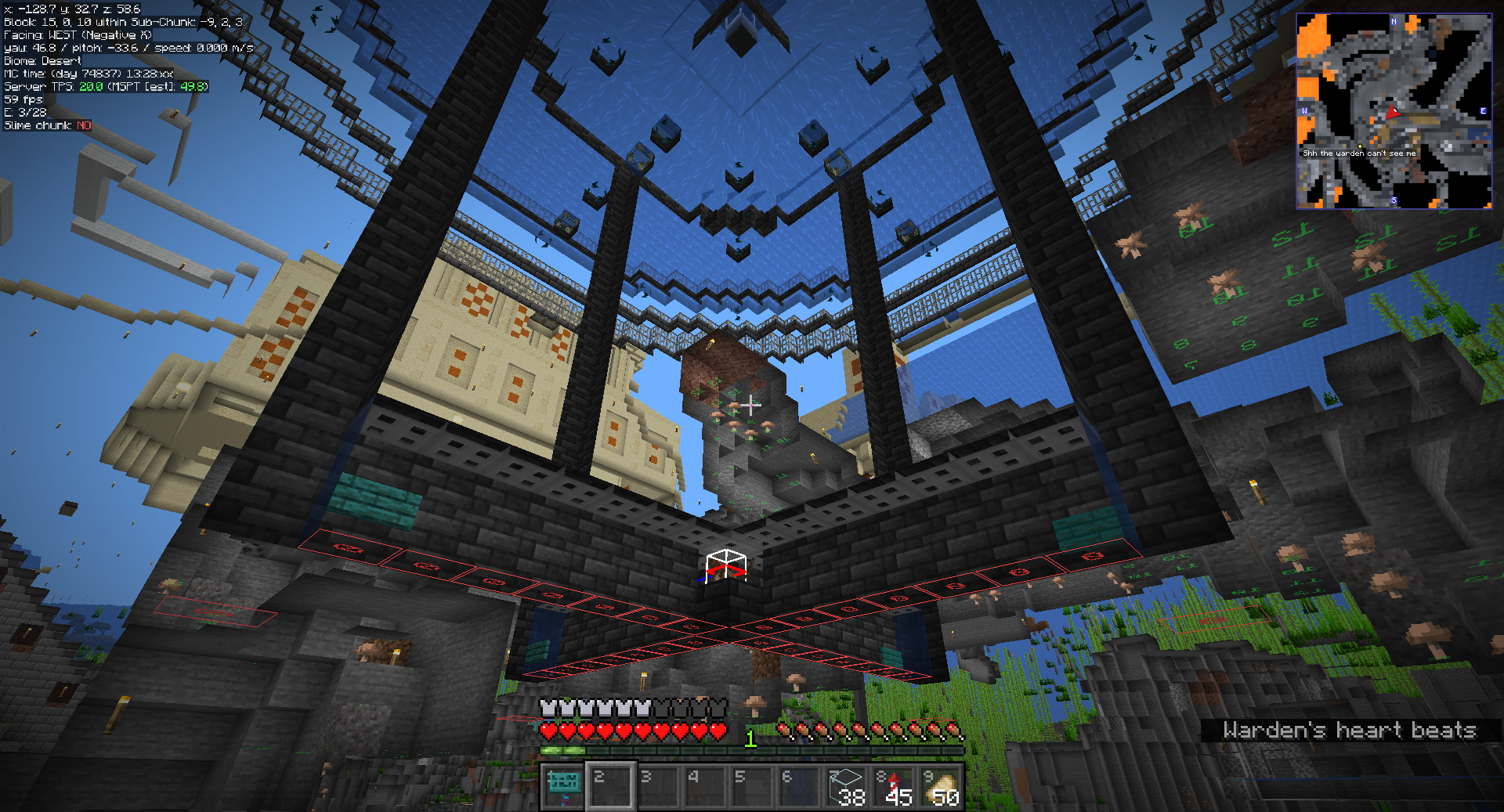

It’s probably more than you are looking for but if you are already looking at self hosting things connected with NextCloud, use NextCloud Talk. We use it for the family and it is great.


It’s probably more than you are looking for but if you are already looking at self hosting things connected with NextCloud, use NextCloud Talk. We use it for the family and it is great.


There were a lot of SpongeBob and Patrick interpretations, the inflatable costumes were huge
This may not be exactly what you want, but I use Apache guacamole for this. The client becomes a web browser, and a chromium based browser allows seamless bidirectional clipboard. I use Ubuntu VMs with Mate as the DM and with a few keybinds tweaked it is solid. I use tightVNC as my server which supports dynamic resize, and the soon to be released guacamole 1.6 supports sending dynamic resize (since the underlying libraries are now updated to support it; RDP in guac already supports dynamic resize). How performant is it? I have a single proxmox vm which runs 3 Minecraft instances for our server’s 3 bot accounts (which just stand still) and the desktop is still navigable.
I’ve read extensively about that, and this thread was very helpful, and my understanding is that’s still not really a DRS equivalent, but more of a recovery mode: https://forum.proxmox.com/threads/ha-cluster-resource-scheduling-filling-in-the-missing-pieces-from-the-docs.139187/
Where do you see the load balancing feature? Searching for exactly that was what got me to ProxLB. I have HA groups and fences, but that’s less resource allocation than failure resolution in my experience. My cluster is 8.2.7.
I posted to the forums, but I got a “YMMV” kind of answer; the docs say it’s technically unsupported: https://pve.proxmox.com/pve-docs/chapter-qm.html#_requirements
The hosts have CPUs from the same vendor with similar capabilities. Different vendor might work depending on the actual models and VMs CPU type configured, but it cannot be guaranteed - so please test before deploying such a setup in production.
I’m setting the CPU Type to x86-64-v2-AES which is the highest my westmere CPU’s can do. I have a path to getting all 3 nodes to the 6525 hardware, pending some budget and some decomm’s at work.
I’m battling this right now; it SHOULD work but does not work consistently. Again, homelab, not ideal environment. I’m going from 2 R710’s with Xeons to a 3-node cluster with the 710’s and an EPYC R6525. Sometimes VM’s migrate fine, sometimes they hang and have to be full reset. Ultimately this was fine as I didn’t migrate much, but then I slapped on a DRS-like thing, and I see it more. I’ve been collecting logs and submitting diagnostics; even pegging the VM’s to a common CPU arch didn’t fix it.
To that end, DRS alternatives are still mostly plugins. This was the go-to, but then it was abandoned:
https://github.com/cvk98/Proxmox-load-balancer
And now I’m getting ready to go deeper into this, but I want to resolve the migration hangs first:
I think you are looking at this wrong. Proxmox is not prod ready yet, but it is improving and the market is pushing the incumbent services into crappier service for higher prices. Broadcom is making VMware dip below the RoI threshold, and Hyper-v will not survive when it is dragging customers away from the Azure cash cow. The advantage of proxmox is that it will persist after the traditional incumbents are afterthoughts (think xenserver). That’s why it is a great option for the homelab or lab environment with previous gen hardware . Proxmox is missing huge features…vms hang unpredictably if you migrate vms across hosts with different CPU architectures (Intel -> AMD), there is no cluster-wide startup order, and things like DRS equivalents are still separate plugins. That being said knowing it now and submitting feedback or patches positions you to have a solution when MS and Broadcom price you out of on-prem.


All you have to do is name tag them and they won’t dig into the ground!


This would make a terrible farm, ultimately the warden just stares at them a lot and half the time they despawn. They also don’t spawn too often, but that’s because this is a zoo with trapped hostile mobs all over and I think it impacts the rates. I also spammed sensors and shriekers to try to make him angrier faster, but it didn’t really help. That being said, you just make a plus farm under them with a cat in the middle; they get scared and run into a bubble column which pushes them into a pool where they can be seen by the warden, but not close enough to hurt him if they explode.
This is for a zoo, so the idea is that viewers can see the warden but not get blasted by him, and can get blindness by going up on the observation platform. Occasionally, like the goat in Jurassic Park, it acts like a predator, but just like in the movie, it’s disappointing a lot of the time lol.




I have a philosophy of sticking close to reference implementations and upstream in the homelab because it forces me to learn principles rather than implementations. I use bind9, but that upstreams to pihole on a different port. It is hard to configure for sure, editing zone files in vi, but I learn a lot analyzing the reference syntax to understand features. I also use isc-dhcp-server for DHCP, again manually populating dhcpd.conf.
Bind can peer with other instances; right now it is it’s own ipam vm on my proxmox with bind/isc-dhcp/pihole docker, but I’m looking at dropping some hardware at a family member’s for a site 2.
I don’t see that post on her page: https://www.instagram.com/lydiawinters/?hl=en
I’m super happy and excited for GIMP 3.0. I hate that this info was presented in a youtube video. I can gleam what I want to know from an article with bullet points (which I could find) but I’m sick of half the information I search for being returned in a video, with a fixed time commitment and imprecise “scrolling” to skip. I feel like in search and link aggregators, more and more content is video instead of text and I’m not here for it.


I totally agree…the best solution for the specific problem. “Cloud” was the buzzword solution to every problem for a few years and it wasn’t great in a lot of cases. High I/O home grown apps to be used from a single campus don’t need to be in the cloud. Bulk archive storage doesn’t need to be in the cloud, things like lecture recordings from 10+ years.


I don’t understand your disbelief here, the 2 major players in online email and account mgmt (for education) are Google and Microsoft and both are 0 cost, but the bait and switch is the limit lowering mid cycle, not even on the academic calendar. Now that exchange on-prem is essentially dead and Google and MS control email via blacklist politics, it’s a captive market.


We had been a university with office365 for several years, and the price change came well after the product comparison and decision was made. Once you are in an ecosystem like that the cost of changing is astronomical when you include migration labor, training, and loss of productivity during the transition. When you are a university with thousands of student, staff, and alumni accounts, and the office, mail, and authentication environments are integrated, it’s realistically functionally impossible to migrate.
The student A1 licenses are 0 cost without upgrades, which is why it was chosen, but the storage change was a blindside. We had hundreds of accounts using over the 100GB of data (which was within TOS) and had tons of data in onedrive which had to be moved or we had to fork out per account. This was a bait and switch, plain and simple, and that is the issue with “cloud for everything” is you are at their mercy.


Completely disagree. This last March, Microsoft changed the storage limit per user on OneDrive for education from 1TB to 100GB, and users either had to delete a ton of files or pay for increased license/space. We ended up standing an on-prem file server back up shortly thereafter because we could not get our users and faculty to delete research data and could not afford to nearly double our cost expenditure. In my experience doing IT budget for years, cloud has meant that you cannot predict your yearly expenditures, Especially if you use your services that are funded in part by venture capital. Let’s say you start using some cool research presentation project and suddenly the economy dips and they lose funding, the cost goes way up. Life cycle management has gone completely out the toilets in my experience with cloud products.


Cloud. Businesses went all in on cloud under this illusion of stable costs, but costs go up and contol/support have gone down, and I’m seeing businesses spin on-prem back up.
This is a good breakdown. A firehose relay takes TB’s of storage and is not practical for self-hosting, and AppView isn’t hostable yet: https://alice.bsky.sh/post/3laega7icmi2q